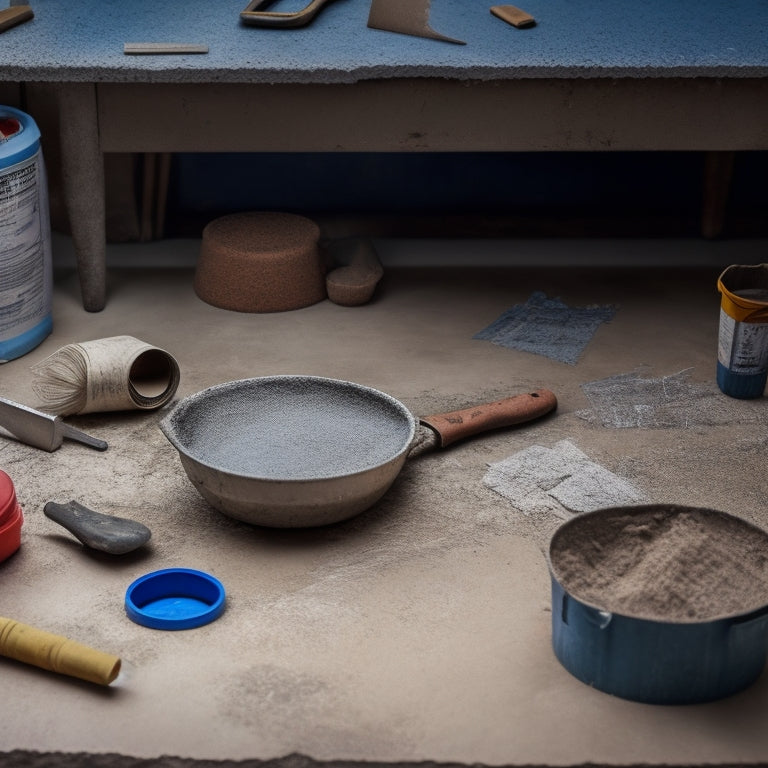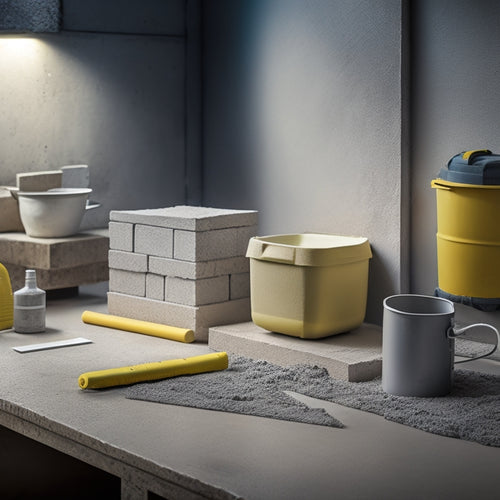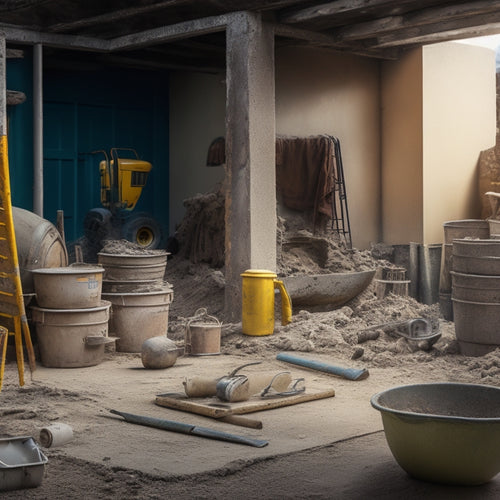
Cost-Effective Solutions for Cracked Concrete Repair Tools
Share
When tackling cracked concrete repair, you'll find that costs can range from a few dollars for basic patching compounds to several hundred for professional-grade systems. Understanding these costs is key to finding the most cost-effective solutions for your specific repair needs. Polyurethane-based patching compounds, for instance, offer durability at a lower cost than epoxy alternatives. Thorough project planning and prioritizing durable tools can also minimize waste and reduce overall costs. By evaluating crack size, location, and complexity, you can make informed decisions and identify the best value for your project - and exploring further will reveal even more opportunities for savings and efficiency.
Key Takeaways
• Cost-effective repair tools include epoxy-based patching compounds, polyurethane foam injection systems, and specialized tools like drills and mixing sticks.
• Polyurethane foam injection pricing ranges from $3 to $15 per linear foot, depending on crack complexity and location.
• Budgeting for driveway repair projects involves estimating material costs, labor costs, and equipment costs, and prioritizing durable and versatile tools.
• Selecting cost-effective materials, like polyurethane-based concrete patching compounds, and implementing cost-saving strategies can reduce expenses without compromising project quality.
• Delayed repairs can lead to hidden costs like water damage, erosion, and safety hazards, making timely action essential for cost-effective solutions.
Cinder Block Crack Repair Tool Costs
Your cinder block crack repair tool costs will depend on the type and quality of the equipment you choose, ranging from a few dollars for a basic patching compound to several hundred dollars for a professional-grade injection system.
When selecting a repair technique, consider the severity of the crack and the desired outcome. For minor cracks, a DIY-friendly epoxy-based patching compound may suffice, costing around $10 to $20 per tube. However, more extensive cracks may require a polyurethane-based injection system, which can cost upwards of $100 to $300.
Additionally, you may need to invest in specialized tools, such as a drill and mixing sticks, to guarantee a successful repair. It's crucial to weigh the cost of the tools against the importance of a professional-looking finish.
Budgeting for Driveway Repair Projects
When planning a driveway repair project, you'll need to create a thorough budget that accounts for all necessary expenses.
To do this, you'll want to identify the essential components of your budget breakdown, including materials, labor, and equipment costs.
Budget Breakdown Essentials
Estimating the cost of materials and labor is vital to budgeting for driveway repair projects, as it helps determine the overall financial investment required to complete the job successfully. When creating a budget, you'll need to take into account the cost of concrete patching compounds, sealants, and other materials necessary for the repair. Additionally, you'll need to factor in the cost of labor, including the time and effort required to complete the job.
To develop effective budgeting strategies, you should prioritize repair tool selection. Choose tools that are durable, versatile, and suitable for the specific tasks at hand. This will help minimize waste and reduce the overall cost of the project.
Evaluate the cost of renting or purchasing specialized equipment, such as concrete grinders or saws, and factor this into your budget. By accurately estimating the cost of materials and labor, and selecting the right repair tools, you can create a thorough budget that guarantees your driveway repair project stays on track financially.
Cost-Saving Strategies
By implementing cost-saving strategies, you can greatly reduce the financial burden of driveway repair projects, ensuring that your budget stays on track and your financial goals remain within reach.
One effective approach is to select cost-effective materials that meet your project's requirements without breaking the bank. For instance, consider using polyurethane-based concrete patching compounds, which offer excellent durability at a lower cost than epoxy-based alternatives.
Additionally, thorough repair project planning can help you avoid costly mistakes and optimize resource allocation. Take the time to assess the extent of the damage, identify the root cause, and develop a detailed scope of work to guide your repair efforts. By doing so, you'll be able to prioritize tasks, allocate resources efficiently, and minimize waste.
Furthermore, consider scheduling your repair project during the off-season when contractors may offer discounted rates. By adopting these cost-saving strategies, you'll be able to achieve a successful driveway repair project that meets your budget and timeline constraints.
Sealing Cracks With Epoxy Injections
When you're preparing to seal cracks with epoxy injections, it's important to get the crack ready for the repair.
You'll need to clean and prepare the crack surface to guarantee a strong bond between the epoxy and the concrete.
Next, you'll need to select the right epoxy injection technique to effectively fill the crack and restore the structural integrity of the concrete.
Crack Preparation Methods
Crack Preparation Methods
You'll need to clean and prepare the crack surface to secure a strong bond between the concrete and the epoxy injection material. This step is essential in guaranteeing the success of the repair. Start by conducting a thorough crack assessment to identify the severity and extent of the damage. This will help you determine the most effective surface preparation methods to use.
| Crack Assessment Techniques | Surface Preparation Methods |
|---|---|
| Visual Inspection | Cleaning with compressed air |
| Acoustic Emissions Testing | Wire brushing to remove debris |
| Dye Penetration Testing | Applying a bonding agent |
| Ultrasonic Testing | Grinding to create a rough surface |
Once you've assessed the crack, use the appropriate surface preparation methods to clean and prepare the surface. This may involve cleaning with compressed air, wire brushing to remove debris, applying a bonding agent, or grinding to create a rough surface. By taking the time to properly prepare the crack surface, you'll secure a strong bond between the concrete and the epoxy injection material, resulting in a durable and long-lasting repair.
Epoxy Injection Techniques
With the crack surface properly prepared, you can now proceed to inject epoxy into the crack using various techniques to guarantee a successful repair.
Epoxy injection is a popular method for sealing cracks in concrete due to its epoxy advantages, including high bonding strength, resistance to chemicals, and minimal shrinkage.
There are several epoxy injection techniques you can employ, including low-pressure injection, high-pressure injection, and vacuum injection. Each technique has its own set of equipment and application requirements, so it's vital to choose the right one for your specific repair needs.
When injecting epoxy, you'll need to take into account the viscosity of the material, as well as the temperature and humidity of the environment.
It's also important to verify that the epoxy is properly mixed and applied to avoid epoxy disadvantages, such as poor adhesion or inadequate fill.
By following the manufacturer's instructions and taking the necessary precautions, you can achieve a strong, long-lasting bond that will restore the integrity of the concrete structure.
With the right epoxy injection technique, you can confidently repair cracks and prevent further damage.
Polyurethane Foam Injection Pricing
You'll typically pay between $3 and $15 per linear foot for polyurethane foam injection, depending on the complexity of the crack and the location of the repair. This cost-effective solution is a popular choice for cracked concrete repair due to its numerous benefits.
Polyurethane foam benefits include its ability to expand up to 20 times its original volume, allowing it to fill even the smallest cracks and voids.
Here are some key factors that affect the pricing of polyurethane foam injection:
-
Crack complexity: The more complex the crack, the higher the cost. This is because complex cracks may require additional materials and labor to properly repair.
-
Location: Repairs in hard-to-reach areas, such as crawl spaces or basements, may be more expensive due to the difficulty of access.
-
Quantity of foam needed: The amount of foam required to fill the crack will impact the overall cost of the repair.
The foam injection effectiveness is unmatched, providing a long-lasting and durable solution for cracked concrete. With its competitive pricing, polyurethane foam injection is an attractive option for those looking for a cost-effective repair solution.
DIY Concrete Repair Kit Options
When selecting a DIY concrete repair kit, you'll want to focus on two key aspects: essential repair materials and easy application methods.
You'll need to guarantee the kit includes the necessary components to effectively repair your cracked concrete, such as epoxy or polyurethane-based adhesives and aggregate materials.
Essential Repair Materials
Your DIY concrete repair kit should include a polymer-modified cementitious repair compound, a high-strength epoxy-based adhesive, and a specialized concrete patching mix to effectively address various types of cracks and damage.
These essential repair materials will help you tackle different repair scenarios.
When selecting repair material types, consider the severity and location of the cracks, as well as the surrounding environment. For instance, epoxy-based adhesives are ideal for bonding materials in high-traffic areas or where high strength is required.
Here are three key items to include in your DIY kit:
-
Polymer-modified cementitious repair compound: A flexible and durable material for repairing small to medium-sized cracks.
-
High-strength epoxy-based adhesive: A strong bonding agent for high-traffic areas or where high strength is required.
-
Specialized concrete patching mix: A mix designed for specific types of damage, such as spalling or scaling.
Easy Application Methods
Select a DIY concrete repair kit that offers easy-to-use application tools, such as caulk guns, trowels, and mixing sticks, to simplify the repair process and guarantee a professional-looking finish.
These tools enable you to apply the repair material with precision and control, ensuring a smooth, even finish. By choosing a kit with easy application techniques, you'll be able to complete the repair quickly and efficiently.
When selecting a DIY concrete repair kit, look for quick repair methods that minimize downtime and allow you to get back to using the repaired area as soon as possible.
Opt for a kit that includes a high-flow caulk gun, which allows for fast and easy application of the repair material. Additionally, consider a kit that includes a trowel or putty knife for smoothing out the material and achieving a professional finish.
Professional Repair Service Estimates
Estimators from professional repair services assess the cracked concrete damage to provide you with a detailed, itemized quote outlining the necessary repairs, materials, and labor costs.
This quote serves as an essential tool for comparing repair service estimates, guaranteeing you get the best deal for your cracked concrete repair.
To guarantee estimate accuracy, estimators will typically:
-
Conduct a thorough inspection: They'll examine the crack's length, width, and depth to determine the extent of the damage.
-
Identify the repair method: Based on the inspection, they'll recommend the most suitable repair method, such as epoxy injection or polyurethane foam injection.
-
Calculate material and labor costs: They'll provide a detailed breakdown of the materials and labor required to complete the repair, including the cost of any necessary equipment or specialized tools.
Crack Filling Material Cost Breakdown
Calculating the cost of crack filling materials involves determining the quantity of each product required to fill the crack, as this quantity directly impacts the overall expense of the repair. To accurately estimate the cost, you'll need to conduct a thorough crack assessment to identify the type, size, and location of the crack. This will help you choose the most suitable material for the job.
When comparing materials, consider the following factors:
| Material | Cost per Unit |
|---|---|
| Epoxy-based filler | $5-10 per liter |
| Polyurethane-based filler | $10-20 per liter |
| Acrylic-based filler | $15-30 per liter |
| Silane-based sealer | $20-40 per liter |
As you can see, the cost of crack filling materials varies considerably. By understanding the characteristics of each material and their corresponding costs, you can make an informed decision about which one to use for your repair. Remember to factor in the quantity needed and the complexity of the repair when making your material comparison. This will guarantee you get the best value for your money.
Hidden Costs of Delayed Repairs
When you put off repairing cracked concrete, you're likely to incur additional expenses that can far exceed the initial cost of the repair. Delaying repairs can lead to hidden consequences that will cost you more in the long run. By neglecting to address the issue promptly, you're opening yourself up to future expenses that could have been avoided.
Here are three ways delaying repairs can cost you more:
-
Water Damage: Water can seep into the cracks, causing further damage to the concrete and potentially leading to structural issues.
-
Erosion and Spalling: As water freezes and thaws, it can cause the concrete to erode and spall, leading to a more extensive and costly repair.
-
Safety Hazards: Cracked concrete can create tripping hazards, which can lead to accidents and potential lawsuits.
Long-Term Savings of Prevention
By addressing cracked concrete promptly, you can avoid the hidden costs of delayed repairs and reap significant long-term savings. Preventative maintenance is key to minimizing the financial burden of concrete damage. By investing in regular inspections and timely repairs, you can prevent minor cracks from becoming major problems.
Here's a breakdown of the long-term benefits of preventative maintenance:
| Scenario | Short-Term Cost | Long-Term Savings |
|---|---|---|
| Regular sealant application | $500/year | $10,000 in avoided repairs over 10 years |
| Annual crack inspections | $1,000/year | $20,000 in avoided repairs over 5 years |
| Prompt repair of minor cracks | $2,000/year | $30,000 in avoided repairs over 5 years |
| Regular cleaning and joint maintenance | $1,500/year | $15,000 in avoided repairs over 10 years |
| Implementing an all-encompassing maintenance plan | $5,000/year | $100,000 in avoided repairs over 10 years |
Effective Repair Tool Prioritization
You'll need to prioritize your repair tools strategically to tackle cracked concrete effectively, focusing on the most vital tasks and allocating resources efficiently. This involves identifying the most vital areas of damage and selecting the right tools for the job. Effective tool selection is essential to achieving a successful repair.
To prioritize your repair tools, consider the following factors:
-
Severity of damage: Focus on the most vital areas of damage that require immediate attention.
-
Tool functionality: Choose tools that can perform multiple tasks, such as a drill that can also be used for mixing.
-
Cost-benefit analysis: Compare the cost of each tool to its potential benefits, and allocate resources accordingly.
Frequently Asked Questions
What Causes Concrete to Crack in the First Place?
As you examine the concrete, you're likely wondering what causes it to crack in the first place.
You'll find that concrete shrinkage is a primary culprit, as it naturally contracts over time.
Weather fluctuations also play a significant role, as temperature and humidity changes cause the concrete to expand and contract.
This repeated stress leads to cracks, especially when the concrete is young or has been poorly mixed.
Are There Any Eco-Friendly Crack Repair Tool Options Available?
When searching for eco-friendly crack repair tool options, you'll find sustainable materials gaining traction.
Look for tools that utilize recycled materials or bioplastics, reducing waste and environmental impact.
Eco-friendly sealants, such as plant-based polyurethanes or silane-modified polyethers, offer a greener alternative to traditional chemicals.
These innovative solutions not only benefit the environment but also provide effective, long-lasting repairs.
Can I Use Paint to Cover up Small Concrete Cracks?
Imagine a thin veil of imperfection hiding beneath a fresh coat of paint, only to be exposed again with the next rainstorm.
When it comes to covering up small concrete cracks, you might be tempted to reach for a can of paint. However, you'll need to choose the right type - acrylic or epoxy-based paints work best.
Keep in mind that paint is only a cosmetic solution; for a more permanent fix, consider using crack fillers specifically designed for concrete repair.
How Long Does a Typical Concrete Repair Project Take?
When tackling a concrete repair project, you're likely wondering how long it'll take to get the job done.
The repair timeline largely depends on the scope of the project, the number of cracks, and the repair method you choose.
By prioritizing project efficiency, you can minimize downtime and get back to normal operations quickly.
On average, a typical concrete repair project can take anywhere from a few hours to several days, depending on the complexity of the repairs.
Are Concrete Crack Repair Warranties Usually Available?
When you invest in a concrete crack repair, you'll often find that warranty coverage is available.
In fact, many contractors and manufacturers offer repair guarantees that can provide you with peace of mind.
These warranties typically range from a few years to a decade or more, depending on the type of repair and materials used.
Be sure to ask about warranty options and what's included in the coverage before hiring a contractor or purchasing a repair product.
Conclusion
As you weigh your options for cracked concrete repair, it's clear that cost-effective solutions are key.
Coincidentally, the most affordable approaches often yield the most durable results. By prioritizing epoxy injections, polyurethane foam, and DIY kits, you'll not only save money but also guarantee a long-lasting fix.
Meanwhile, delaying repairs can lead to hidden costs and a heavier financial burden.
Invest in prevention and prioritize the right tools – it's a coincidence that what's good for your wallet is also good for your concrete.
Related Posts
-

10 Best Tools for Sealed Concrete Flooring on Budget
When starting on a sealed concrete flooring project on a budget, you'll need to prioritize essential tools without sa...
-

What Tools Do I Need for Concrete Block Laying
You'll need a thorough set of tools to guarantee accurate, efficient, and professional concrete block laying. Essenti...
-

What Tools Are Needed for Concrete Wall Foundations
You'll need a thorough array of tools and equipment to construct a concrete wall foundation that meets structural int...


